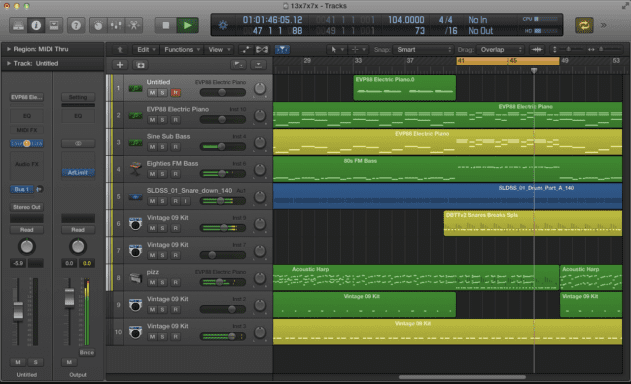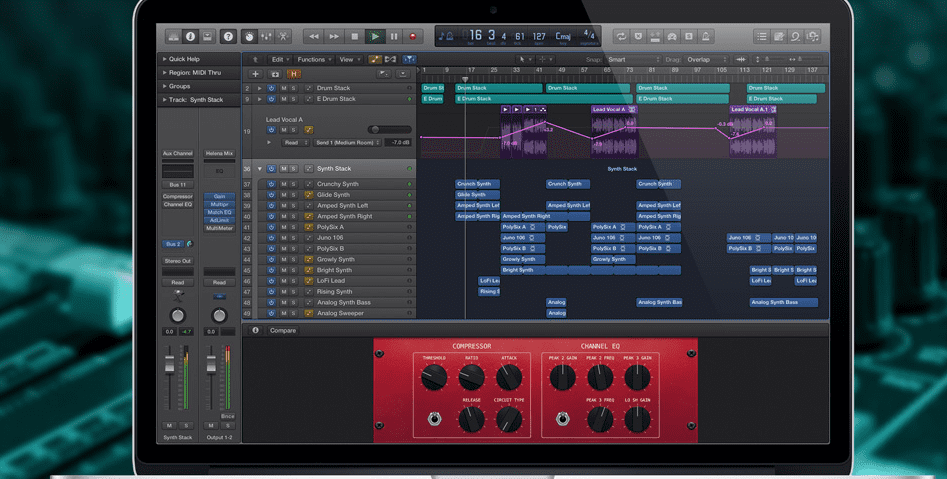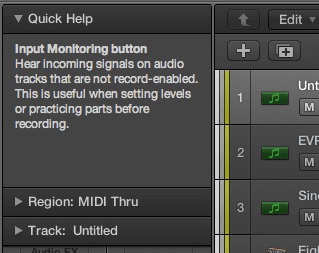Four years in the making, the latest version of Apple’s flagship DAW introduces an overhaul of the interface and some major new features. But how much of the update is relevant to dance producers? (Warning: contains ‘EDM Bass’ presets.)

In the four years since the last Logic update, speculation has been rife regarding the future of Apple’s flagship DAW. Consumers and journalists alike were left completely in the dark as to when we might see a new version. Some even speculated that Apple was cutting its pro app development team and perhaps even discontinuing development altogether. After all, a lot has changed since 2009. In the wake of Steve Jobs’ phenomenal success in revitalising the ailing company’s business model, pro users have had every reason to suspect that niche software like Logic is now a lower priority to Apple than iPhones, iPads and iPods.
Apple announced the release of Logic Pro X in typically singular fashion, sending out a press release on Tuesday morning to inform the world that the new version was available from the App Store.
With new features such as Amp Designer, Pedalboard and Flex Time, there was a sense with Logic 9 that Apple’s focus was largely on live band recording and an attempt to consolidate the DAW’s position in the pro studio market, competing with the likes of Pro Tools and Nuendo rather than taking on Ableton Live and Reason for the electronic music userbase. Version X (see Apple’s online knowledge base for pronunciation guidelines – that’s ten, not ex) follows suit. Don’t expect an overtly dance music-focussed upgrade here; instead, we’re looking at a refinement of the existing features, a number of which happen to be highly relevant to dance music producers, and perhaps most importantly of all a major overhaul of the software’s GUI and workflow.
Pro Apps
For hints of the overall ethos behind Apple’s development strategy for Logic, we can look to the company’s other Pro Apps: Aperture, Motion and Final Cut. It’s the latter which is of most interest since its recent history has notable similarities with Logic. Like Logic, Final Cut was based on code inherited from another developer (Logic was originally developed by Emagic, formerly C-Lab, members of whose development team joined Apple when it bought the company in 2002; Final Cut was originally developed by Macromedia).
It was widely speculated that the long delay in updates meant that Logic was being rewritten from the ground up, just as Final Cut was for version X. Furthermore, could the delay indicate a shift in focus? In that time, GarageBand has become a staple of Apple’s software offering and the GarageBand app for iOS has been released – both, of course, drawing accusations of dumbing down music software. Would Apple target a prosumer market, focus on bridging the gap for GarageBand users and leave pros in the lurch?
Logic Pro X certainly lives up to some of our expectations – notably in terms of closer integration with the look, feel and workflow of GarageBand – but it isn’t the ground-up rewrite some of us expected (or even hoped for). In light of the debacle surrounding the release of Final Cut Pro X, where long-term users were left infuriated by the omission of key features, that might be a good thing, but if there was a fundamental reason why Logic 9 wasn’t suitable for your production process – lack of multi-core support, perhaps, or the absence of automatic latency compensation for external MIDI instruments – then Logic X probably won’t answer your problems.
To allay long-term Logic users’ fears, let’s make one thing clear at this point: the ‘GarageBand Pro’ jibes are completely unfounded – yes, the overhauled GUI takes cues from Apple’s current design ethos, which unsurprisingly leads to visual similarities between products in the same family, but, as Apple’s promotional material was so keen to point out, features haven’t been lost along the way. Ultimately, one man’s idea of dumbing down is the same as another’s idea of making the software easier to use. Most importantly, all the functionality of Logic 9 remains intact; despite the GUI changes, there definitely hasn’t been a dumbing down in terms of features.
Logic X isn’t the ground-up rewrite some of us hoped for.
With the move to download-only App Store distribution and the discontinuation of boxed versions, Logic Studio – which came as separate Express and Pro versions in version 9 – has now been simplified to just one version: Logic Pro. The live performance sister app MainStage has also been split off to a separate application (also updated to version 3 and available now priced at £20.99).
Headline features
The most obvious and immediately apparent change is the introduction of an entirely redesigned interface. The new look clearly takes cues from Final Cut, GarageBand and the GarageBand app for iPad, right down to the inclusion of identical icons in some cases.
It doesn’t seem too much of a stretch to suggest that Scott Forstall’s fingerprints are all over this unashamedly skeuomorphic design. Given Forstall’s recent ignominious departure from Apple and Jonathan Ive’s subsequent renouncement of the former senior vice president’s design ethos, it does make us wonder whether we’ll see another complete redesign for Logic XI.
Whatever might happen in the future, the Logic X interface has enough in common with Logic 9 that existing users will immediately recognise most elements, although there are also notable changes which will require a little work to re-learn existing features. This isn’t just a reskinned version of the Logic 9 interface, but a rethink of the placement, functionality and naming of existing features. Tool selection, for instance, is updated and simplified – a small but significant improvement on the old system. Likewise, just when we thought we’d published the definitive guide to DAW swing, along comes Apple with another subtly different approach (we’ll be updating our guide to include details of the new swing slider in Logic X’s piano roll in due course).
Elsewhere, we see the arrival of two new Track Stack options. Folder Stacks are based on the old folder feature (which also remains intact), allowing tracks to be grouped together. Summing Stacks are more advanced, working as a form of bussing and allowing multiple instruments to sit on the same track for layered sounds with complex effects and routing. This works in tandem with the new Patches feature to allow entire track stack settings – including multiple instruments, effects and routing – to be saved and recalled, similar to Ableton’s instrument racks.
Other significant changes to Logic’s workflow include a new Arrangement Track similar to Cubase’s Arranger Track, a Groove Track which makes it easy to set up a master groove template for the entire project (another feature adopted from GarageBand), and new Smart Controls – essentially an assignable set of macros for controlling the instruments and effects on a track.
Overall, the interface is cleaner, clearer, more intuitive and – excuse the pun – more logical than Logic 9, but the general appearance is also more light-hearted than previous versions, which won’t be too everyone’s taste. The new Retro Synth, for example, is a lot more attractive than the old ES1 and ES2 but the back-to-basics interface could easily be seen to be targeting amateurs and hobbyists. Our view is that if it sounds good it is professional, but there are undoubtedly countless graphical elements in Logic X which you could never imagine appearing in, say, Pro Tools.


12.24 PM
You can insert more than 1 midi plugin per channel by the way…. Just click on the green thin line underneath the current midi plugin (mixer view)
12.36 PM
So you can. Thanks for the tip!
05.41 PM
I bought Logic X the day it came out, much easier on the eye and the midi fx are great and work well with external synths – I now have an arp on my Juno 106 for example.
You mention in your review drummer can play a different drum plugin – how do you set that up?
Keep up the good work, always check in every few days to see what’s on the site
Cheers
07.46 PM
@ Mr Bump
Just load the Drummer track, then change the instrument from Drum Kit Designer to anything you like. This is presumably why Drummer is a distinct track type rather than a software instrument with built-in sequencer – the Drummer interface (i.e. the pattern creation side of things) stays intact even when you change the instrument.
Aside from the obvious drum and percussion applications, you can create some quite interesting effects by inserting the Transpose MIDI effect and forcing the drummer’s output to trigger notes from a suitable scale.
10.04 PM
Ah yes! Nice one thank you, hours of fun ahead..
05.52 AM
This was a VERY insightful and objective article. Thank you!
05.27 AM
Apple need to address Logic 9 upgrade issue….
Thousands of ill-informed Logic 9 purchasers, only to see the X launched at same price… Boo to Apple’s new inethical business practice!!
And yes, this Toy is definitely not for the Pro, so i bet the Pros are being dumped by Apple in favour of new entrants, alternative songsters and dubstep aficionados…
Again, Booo to Apple for their Logic 9 misconduct and lowly marketing practice!!
05.51 PM
I find it hard to understand how people are complaining about not offering upgrade discounts when the cost of the software at £139 is already dirt cheap. The cost of upgrading ableton 8 to 9 is 250 euros, which is considerably more (and only accessible to people who own the existing software). Putting it at £139 for everyone is both massively cheaper than any other competing software and also far cheaper than most other upgrades. Would these folks feel better if they paid £600 for the full software and then got a £250 upgrade, or just pay £250 for the software and then again for upgrade? If it’s the former then I’m amazed some of these people have managed to even get their heads round turning the computer on let alone understanding a piece of software.
09.47 PM
@Fuzzy – why is it a toy? Same Logic 9 stuff plus more features.
06.46 PM
“Surely a little update to the GUIs of these plugins wouldn’t have taken more than a few days’ work?”
Hahahaha. That’s a good one. I don’t dispute that they could have used an update, but it’s definitely more than a few days work.